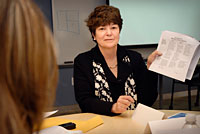Leaders Needed
September 10, 2008 - Building a New Kind of Leadership in Philadelphia Public Schools
"The days of the principal as the lone instructional leader are over," says John DeFlaminis, executive director of the Penn Center for Educational Leadership. "We no longer believe that one administrator can serve as the only instructional leader for an entire school without the substantial participation of other educators."
 DeFlaminis also says a proven approach needs to be more widely used by educators to improve the practice of education: "distributed leadership." With a $4.9 million grant from the Annenberg Foundation, GSE has established the Distributed Leadership Program to help school districts explore the potential of this collaborative leadership model. Led by DeFlaminis, the four-year project is training more than 100 teachers and principals in 16 Philadelphia public schools as instructional leaders to build capacity in their schools and to work in collaboration on broader school-based initiatives in instructional improvement.
DeFlaminis also says a proven approach needs to be more widely used by educators to improve the practice of education: "distributed leadership." With a $4.9 million grant from the Annenberg Foundation, GSE has established the Distributed Leadership Program to help school districts explore the potential of this collaborative leadership model. Led by DeFlaminis, the four-year project is training more than 100 teachers and principals in 16 Philadelphia public schools as instructional leaders to build capacity in their schools and to work in collaboration on broader school-based initiatives in instructional improvement.
"Instead of relying on a single administrator to be a director, organizer, and decision-maker, the distributed leadership model recognizes that teachers can bring their expertise and leadership skills to bear on the issues faced by schools," says DeFlaminis, a former superintendent of Radnor Township School District.
Shawanna James Coles, a teacher at Tanner G. Duckrey Elementary in North Philadelphia, is a participant in the Distributed Leadership Program. She sees distributed leadership as an effective way to lay important groundwork for progress. "You don't want to dictate what's going on, what the new policies are, what the new changes are going to be, but present it in a way where the teachers will buy in, the staff will buy in, the community will buy in, and the children will buy in on any given level."
By sending best practices rippling through schools, distributed leadership aims to give more ownership of ideas and decisions to teachers, at once empowering teachers and freeing principals from unrelenting management tasks. This model should allow principals and teachers to focus more effectively on crucial instructional improvements to advance student achievement.
To determine whether the program will deliver as promised, GSE researchers are evaluating the model even as Coles and her colleagues are learning how to put it into practice. Professors Rebecca Maynard and Jon Supovitz have launched a mixed-methods study that will inform the design and implementation of the program. Right now, they're looking for patterns of improved collaboration among teachers as an indicator of improved instructional leadership. A longer-term, randomized control design study will help measure the impact on student achievement.
"By re-envisioning the role of school leadership in overburdened and complex urban schools like Philadelphia," concludes DeFlaminis, "the Annenberg Distributed Leadership Program aspires to prepare a new generation of leaders with the skills and strategies necessary to sustain high-performing, standards-based schools. . . . With this project, we have a unique opportunity to expand school leadership in a way that will affect learning among children for generations."
